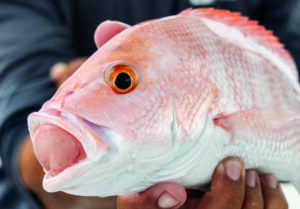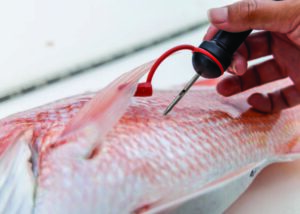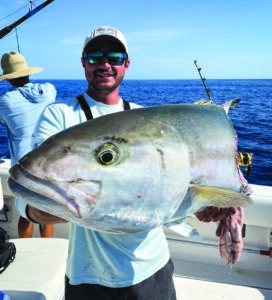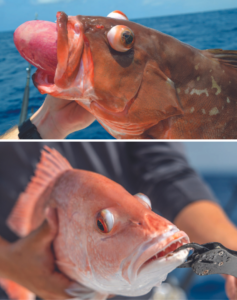New regulations for venting and descending reef fish have sparked conversation and controversy across the Gulf of Mexico. From Facebook fishing groups to online forums and on-the-water fodder, everyone seems to be an expert when it comes to releasing fish. With opinions circulating faster than a frigate diving for food, it’s important to get the facts straight so we can do our best to help fish survive release. Let’s dive right into some of the common myths about barotrauma, venting and descending.
 Myth 1: Just pop the swim bladder sticking out of the mouth.
Myth 1: Just pop the swim bladder sticking out of the mouth.
This prevalent misunderstanding about barotrauma has circulated for years. Most fishermen are aware that reef fish have a swim bladder that expands when reeled to the surface from depth. Many assume the organ sticking out of the mouth of a fish is the inflated swim bladder, but in reality, the swim bladder expands internally and pushes the stomach out of the mouth of the fish. This is known as stomach eversion. Anglers may see some stomach contents expelled upon ascent or near the mouth of the fish when stomach eversion occurs. Another example is when a snapper bites their own everted stomach “deflating” it, yet there is still air in the body cavity from the swim bladder expanding. You never want to pop the stomach coming out of the mouth as it can do more harm than good for the fish and doesn’t successfully release the gases in the body cavity.
Moral of the Story: If you choose to vent fish (although descending is preferred under most scenarios), ensure you are venting the correct spot behind the pectoral fin!
 Myth 2: Descending devices spoon-feed sharks and dolphins.
Myth 2: Descending devices spoon-feed sharks and dolphins.
This argument primarily arises from anglers having their catch eaten while fighting it to the surface, commonly referred to as depredation. If you are an avid offshore angler, more likely than not you’ve reeled up a half of a fish before. The simple truth is that a fish being descended acts nothing like a fish fighting for its life on the way up. Sharks are attracted to the vibrations and struggle of a fish fighting to survive and get off the hook. Spearfishermen are aware of this as you are more likely to have your fish eaten by a predator when it is struggling on the shaft rather than when you gain control of the fish.
If the subjective evidence isn’t enough for you, let’s look at some data:
– Runde et al. (2022) examined depredation on descending devices off the coast of North Carolina by descending fish in capture depths of 24 to 244 meters. Of 1,176 non-videoed descents, zero descending devices were lost to predators. Of 114 videoed descents, predators were observed seven times with zero instances of depredation observed. o https://afspubs.onlinelibrary.wiley.com/doi/pdf/10.1002/nafm.10815

Researchers from Mississippi-Alabama Sea Grant are teaming up with charter captains across the Gulf of Mexico to examine depredation of descended reef fish with GoFishCams attached to the line. Through one season of data collection, seven captains descended 464 fish with an average capture depth of 114 feet. The team examined the video footage and found one instance of depredation by a shark, one predation event after release by a dolphin and the rest were successful releases, including a few with predators in the frame. These results are preliminary as the study is ongoing. o https://masgc.org/news/article/depredation-on-descender-devices-an-update
You’d be naïve to say that sharks, barracudas, dolphins, or other predators will never eat descended fish, but it’s much rarer than on ascent and not a reason to dismiss descending devices. If the sharks are fired up under your boat, you’re unlikely to get a fish to the surface anyway and moving spots is the best course of action. Dealing with predators is one issue while barotrauma and discard mortality is an entirely separate issue.
Moral of the Story: Letting a fish float off on the surface is spoon-feeding predators and a vented fish still has to swim wounded and tired past predators to the bottom to survive. Don’t knock descending devices until you give them a shot!
Myth 3: That fish is dead anyway.
Our last myth comes from the gruesome image of a fish fully blown up from barotrauma. When anglers see the eyes bulging out of the head or the stomach protruding from the mouth of a fish, they often think it has zero chance of surviving release. In reality, a fish that looks lifeless at the surface often has a great chance to survive release to grow, spawn and contribute to the future of the stock.
Let’s look at three lines of evidence that debunk this myth:
1) Video Releases: Underwater videos attached to fishing line have been used for years to determine what happens while fish are being descended. In many instances, you can see the fish recompress as it’s being descended and seemingly come back to life. Return ‘Em Right is a great resource to see some of these videos.
2) Acoustic Telemetry Studies: Researchers will often tag fish with transmitters that track their movements after release. By examining these movements, they can document long-term survival of fish suffering from barotrauma.
– Runde et al. (2021) tagged 44 red snapper with electronic transmitters, monitored their movements and found 87% of red snapper survived release when caught and descended in roughly 120 feet of water off North Carolina.
i. https://afspubs.onlinelibrary.wiley.com/doi/10.1002/mcf2.10175
– Wegner et al. (2021) used acoustic telemetry to evaluate long-term survival of rockfish off California and found “… that physoclistous fishes captured at depths up to ~180 meters (590 feet) and experiencing extreme barotrauma can survive if properly released using a descending device, and that increased capture depth for such deeper-dwelling species does not necessarily increase mortality.”
i. https://academic.oup.com/icesjms/arti¬cle/78/9/3230/6378054
 3) Mark-Recapture Studies: Tagging fish with simple dart tags and evaluating which ones are recaught provides valuable information on which release types are most successful.
3) Mark-Recapture Studies: Tagging fish with simple dart tags and evaluating which ones are recaught provides valuable information on which release types are most successful.
– Stallings et al. (2023) found that red snapper and red grouper were two to two and a half times more likely to survive release when descended to 20 meters than when vented, per tag return data. Fish descended to only 10 meters had similar survival rates to those vented.
Moral of the Story: Not every fish will survive release but it’s our responsibility to give each one their best shot!
Return ‘Em Right to Earn Another Fight
The Return ‘Em Right program offers anglers a free 15-minute online education module on barotrauma, venting and descending. Upon completion, offshore anglers that fish in the Gulf of Mexico will receive $100 worth of release gear for FREE. Yes, it is completely free. If you haven’t gotten your gear from them, don’t wait too long! Visit returnemright.org for more.